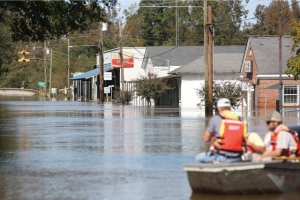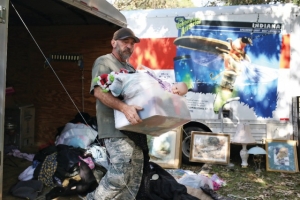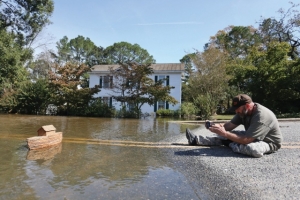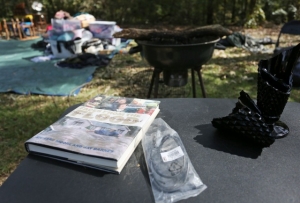Loss of Seven Springs?: Flood victims doubt return
By Ethan Smith
Published in News on October 15, 2016 10:11 PM

News-Argus/CASEY MOZINGO
A view of downtown Seven Springs from Highway 55 shows flood levels in the town Saturday as water continues to recede following Hurricane Matthew. Many of the town's residents left following Hurricane Floyd in 1999 and many of the remaining residents are making plans to live elsewhere to make their recovery.

News-Argus/CASEY MOZINGO
Barry Guevremont sorts through his family's belongings Friday in Seven Springs after packing as much as they could into a car, van, box truck, trailer and U-Haul as the water left by Hurricane Matthew began to flood the Neuse River. Guevremont and his family packed as quickly as possible, even throwing things out of the window to save time.

News-Argus/CASEY MOZINGO
Barry Guevremont takes a photo of a miniature wooden arch in the flooded waters of the Neuse River on Main Street in Seven Springs Friday. His humor never leaving in the wake of yet another devastating flood.

News-Argus/CASEY MOZINGO
One of Guevremont's belongings that was packed into the trucks is a book titled "Faces from the Flood" by Richard Moore and Jay Barnes, that recalls flooding from Hurricane Floyd in 1999.
SEVEN SPRINGS -- Barry Guevremont sleeps inside a box truck now.
He uses his daughter's bed, tucked behind a tarp in the back of the truck that separates him from the outside world.
His box truck is parked on some of the only high ground in Seven Springs -- the parking lot of Seven Springs United Methodist Church.
His home, sitting at 201 W. Spring St., is sitting porch-deep in floodwater that came rushing into town after Hurricane Matthew left.
"I figured God would let us stay here so I didn't have to ask permission," Guevremont said. "This is a good spot to watch our house and keep an eye on the water receding."
Guevremont kayaked through the town on Wednesday to view the flood damage, and said his house still remains inaccessible because of the high water.
"I knew something very bad was going to happen because New Street and Spring Street flooded with knee-deep water during the flash flooding caused by the storm," Guevremont said.
Guevremont's belongings -- everything he could shuttle out of his house in a hurry -- are strung about a grass patch in the church parking lot. They are divided between a mini-van, a car, a rented U-Haul and the box truck where he sleeps.
He said he did not have to leave during the flash flooding, but rather when the Neuse River started rising early in the week.
"The water was on Main Street, but you could still get across, so I drove to Goldsboro and rented the U-Haul and brought everything I could up to the church here," Guevremont said. "We literally had our windows open, and we were throwing things out the window into boxes, just trying to get out as fast as we could."
Guevremont lived in Seven Springs during Hurricane Floyd, too.
The house he lives in now stood through the 1999 storm also, making this the second time it has flooded because of a hurricane.
He purchased it for $25,000 because of the flood damage it had sustained, repaired it, made it his own -- and then raised it above the water level the flooding from Floyd reached.
Still, Guevremont said, it was no use. The flooding caused by Hurricane Matthew was so severe he estimates his house has four inches of water inside of it more than a week after the hurricane hit.
"They called it the flood of the century -- this is the new flood of the century," Guevremont said.
In a video Guevremont shot documenting the damage from Floyd, he points to the hazardous material sign on the side of the Supply Store on Main Street. The water had risen to the bottom point of the diamond-shaped sign in 1999.
Then, he pulls out his smartphone.
A picture, taken Wednesday, shows the floodwater that poured in after Matthew.
On it is the same street, the same store, the same diamond-shaped sign. But this time the water has risen to the top point.
"Sixteen years is a long time to remember," Guevremont said. "They said this one would be worse, so I wanted to see what was coming."
Guevremont has no desire to continue residing in Seven Springs.
He said if the Federal Emergency Management Agency (FEMA) does not offer him a buyout he will be sleeping in his box truck for the foreseeable future until his home can be repaired.
"I was hoping not to go back," Guevremont said. "I've put more than $30,000 into flood insurance, so if they give me a full buyout it's enough to pay everything off and move."
But Guevremont is not confident the buyout will come.
He said since only a few inches of flood water had made it into his home, an inspector that visited him Friday told him he would likely be given some money to help repair damages instead of offering a full buyout.
"You would think their job is to make you whole again, but the inspector told me it's more like if you have five televisions, and four of them are damaged, but you still have one left, then you're good," Guevremont said. "So then you wind up with old, wet, saggy plywood mixed with new wood and you're left with an unstable house. The few inches of water in my house will seep into the drywall like a sponge."
Seven Springs currently looks like a ghost town due to the mass evacuation of people from their homes during the flood.
But, both Guevremont and Maynard Price, who owns Maynard's Entertainment and has lived in Seven Springs his entire life, fear that Seven Springs could become a ghost town, permanently.
Both men said the town would be lucky if even 20 people returned this time.
After Floyd, only around 60 people came back to town, effectively cutting the population in half.
"I don't think much will be left," Price said. "Everyone I've talked to has said they're not coming back."
Price opened up Maynard's as a staging area for first responders - swift water rescue teams, dive teams and the National Guard - on Monday.
Since then, congregations from each church in Seven Springs have fixed a meal a day for the men and women working to ensure people's safety during the disaster.
"It kind of evolved as the place where people gathered because it's the highest land around that's close to everything," said Price's wife, Tammie.
But once the first responders leave when the water recedes, nobody is sure a significant population will inhabit the town again.
"It dries up. I have not heard anybody say they're coming back," Price said. "Probably not even 20 people will come back. Maybe a handful will."
Price said it is tough to realize the full extent of the history and the community that could be lost if the oldest town in Wayne County disappears. Many people who inhabit the town are already grieving the uncertainty of its future and its possible death, Mrs. Price said.
"This wasn't like Floyd. It's like everyone knows this is it," Mrs. Price said. "Nobody ever dreamed this would happen again."
